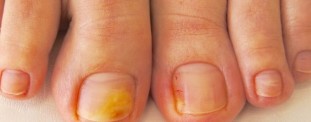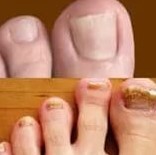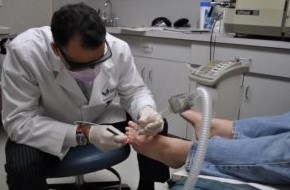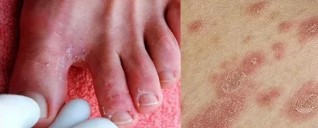Fungal infection in nails of the feet, is widely spread. There are many different types of nail fungus in the foot, and the treatment depends on the type of infectious agent. The cause of this disease is not a lack of hygiene, but the fact is that many of them are compelled to get throughout the working day to be in his shoes.

The core of the infection, and the development of the disease it is of a contact, fungal to the dispute with the skin of the feet. The micro-organisms to penetrate into various cracks, burrs, sharp edges of the corruption. In virtually every case, the fungus goes under the nail, it will immediately begin to acquire the appearance.
The most common types of
The itching, the change of the nail plate is a common symptom of the disease, which is celebrated in all its shapes and forms. There are more signals, depending on the type of infectious agent. So, what are the different types of mold that are out there?
Dermatophyte
In this way, it develops in contact with the pathogens, Trichophyton, Microsporum, and Epidermophyton.
The man may experience the following symptoms:
- the appearance of the grey, and the yellow lines on the boards. The first spots appear on the nail, slowly turning the surrounding;
- on the nail, it will gradually begin to come on to the back of the store.
Mold
Mold is able to surprise not only the products but also the skin and nails of the feet of the individual. The main symptom of this form of pathology of fungal diseases is a change in color.
With a healthy shade of pink, they turn into nasty, red, brown, or green. Not least of the common symptoms are the appearance of dark spots, spots.

Yeast
You will be paid for the sake of being infected with a Candida fungus. A negative feature is the high possibility of failure, full stop. The main symptoms include the following:
- The surface of the nail becomes very thin, so they break down more quickly.
- The nail plates to change the color and the design.
- To the extent that, in the course of the disease is observed, the stronger the peel.
- Your fingers are constantly swollen, to get the color to be red.
This infection is spread by contact with moisture. It is for this reason that it is important to follow certain preventive measures when you visit the swimming pools, changing rooms, shower areas, of the soul.
The classification by stage of development,
To give a better the treatment, the physician should identify the degree of development is reached, the disease, which is the competent body to determine the stage of the fungus on the feet. To the extent that the development of infection and pathology, it starts to spread, not only in the nearby located, on the nails, but also good for the skin, hit in the whole of the foot.

Forms of the disease based on the stage of its development:
- Normotroficheskie, in which there is a change in the color of your nails, there is a risk, but the shape is not changed. It is in the early stage of the infection.
- Depending on what changes in the nail. It is very easy to break, it becomes a subtle, and thus the patient is at a huge disadvantage.
- Atrophic. The board, in this case, it becomes significantly thinner, and it fades, it changes the shape of the nail bent over and quickly disposed of. In this phase, the nail plate begins to move away from the bed. The treatment is very difficult, as the disease was beginning to gain in is to run the form.
Competent therapy
To get rid of the disease is possible only with the help of the competent body for the treatment. It depends on the type of fungus, and you'll be sure to tell the stage of the disease.
The doctor carries out a medical professional in the research, sets out the manner and to the type of fungus that is, by studying the individual characteristics of the body and gives it the treatment.
The choice of the layout
The medicine has three major treatment plans, the system is integrated, and therapy, outside of the media. In the first case, you are supposed to purchase drugs in the form of a tablet or capsule form. Many of them have a large number of side-effects.
When it is integrated with the therapy that is given for the treatment not only of medicine, but also by local drug use. When the outside is scored and the least number of side-effects, it is because of this layout is the most preferred.
An important point on the outside of the treatment will help, it is only in early disease, that is, if you hit less than a third of the nail plate and no more than two toes of the foot.

During the treatment, in almost all the stages and all the forms that are assigned to the background outside the methods of treatment. These are topical creams, lacquers and varnishes, and solutions. Lucky enough to have the action completely on the nail fungus on the feet, it does not affect the hand are located in the tissue.
Between the exterior of the modes of treatment that are often used in the types of creams. They are not only an efficient way to resolve all of the signs of disease, but also to soften and moisturize the nails, thus, reducing the indicators of despair. Regardless of the method you choose and the treatment of the fungus and the medication, it is important to follow the instructions of the specialist and the drug. This is the only way to achieve the maximum positive outcome of the treatment. This is the only way the treatment will provide you with an anti-fungal effect, and the best antibacterial action.
The number of scoring techniques and it depends on the medicine, and also on the type of fungus, and the form of the development. Generally, it is a two-to three-times-a-day.
If you are used to the outdoors, and a cure for the fungus, before you apply the pen to draw in with the aid of special tools, the Horny times. This will strengthen the soulful, the ability of a drug, it's going to help you much faster to be able to have a positive effect, regardless of the type of the species.
In short
For the duration of the treatment of the fungus, on average, it takes 6 months, it was only after that that there has been a healthy growth of the updated card to the nail. To achieve this result, the treatment often does not end, it must continue to achieve strong effect, and it will not be completely prevented, the recurrence of the disease.





























